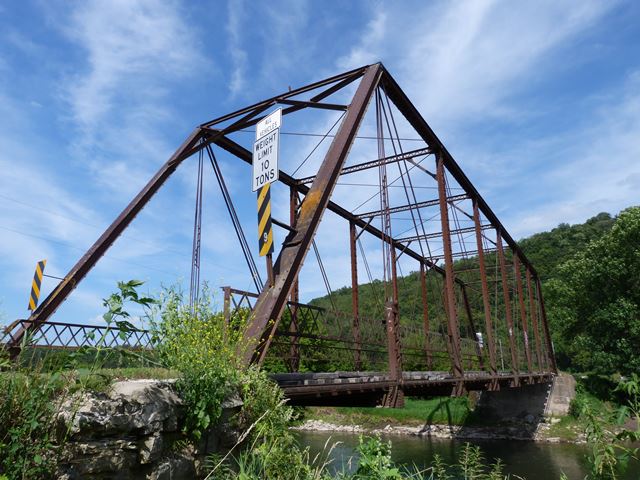We Recommend:
Bach Steel - Experts at historic truss bridge restoration.
BridgeHunter.com Phase 1 is released to the public! - Visit Now
Henry Bridge
Iowa Bridge Number 348910, Hutchinson Bridge

Primary Photographer(s): Nathan Holth and Rick McOmber
Bridge Documented: June 30, 2009 and August 9, 2013
Rural: Winneshiek County, Iowa: United States
1911 By Builder/Contractor: Clinton Bridge and Iron Works of Clinton, Iowa (Possible Builder)
Not Available or Not Applicable
120.0 Feet (36.6 Meters)
121.0 Feet (36.9 Meters)
15.4 Feet (4.69 Meters)
1 Main Span(s)
348910

View Information About HSR Ratings
Bridge Documentation
This bridge no longer exists!
Bridge Status: This historic bridge was demolished for an ugly replacement slab of concrete in July 2021.View Archived National Bridge Inventory Report - Has Additional Details and Evaluation
This eight panel bridge is a traditionally composed example of a bridge type that was in its time the most common type of bridge built, but is today becoming rare at a rapid rate due to demolition. The 1911 bridge is noteworthy because it is what the mainstream of bridge design at the end of the pin-connected truss era. With no usual or distinctive details it provides a clear example of what an "average" bridge of this period would have looked like. In our efforts to single out rare and unusual historic bridges, it is important to also preserve some of these more "normal" historic bridges, in order to retain a clear physical record of bridge construction in that period of history.
This bridge retains fair historic integrity. The bridge has been altered by the addition of cables, however original bridge material does not appear to have been removed or harmed, with the exception of holes created to feed the cables through.
The bridge includes a detail that appears on a number of pin-connected truss bridges, but is still worthy of mention, which is a segmented hip vertical, with the top three quarters being an eye bar, and the bottom quarter being a built-up beam, and an intermediate pin connection to connect these two parts. Hip verticals are the black sheep in a Pratt truss, since they tend to be in tension rather than in compression like the rest of the vertical members, so often eye bars were used at the hip vertical instead of the built up beams usually used on the other vertical members. This however presented a problem for bridge builders, since with an eyebar hip vertical and the inherent slim profile of an eyebar, it was difficult to attach the railing at the hip vertical. On a traditional built-up beam vertical with back-to-back channels connected by lacing or lattice, the railing would simply be bolted or riveted on. However, this was not possible to do with an eyebar. Solutions for attaching railings to these troublesome hip verticals varied, but one solution was to run a built-up beam on the hip vertical up from the bottom chord just far enough to provide a railing attachment, and then run the eyebar for the rest of the distance to the top chord. The Henry bridge is an example of this solution.
![]()
Photo Galleries and Videos: Henry Bridge
Bridge Photo-Documentation
Original / Full Size PhotosA collection of overview and detail photos. This gallery offers photos in the highest available resolution and file size in a touch-friendly popup viewer.
Alternatively, Browse Without Using Viewer
![]()
Bridge Photo-Documentation
Mobile Optimized PhotosA collection of overview and detail photos. This gallery features data-friendly, fast-loading photos in a touch-friendly popup viewer.
Alternatively, Browse Without Using Viewer
![]()
CarCam: Westbound Crossing
Full Motion VideoNote: The downloadable high quality version of this video (available on the video page) is well worth the download since it offers excellent 1080 HD detail and is vastly more impressive than the compressed streaming video. Streaming video of the bridge. Also includes a higher quality downloadable video for greater clarity or offline viewing.
![]()
Maps and Links: Henry Bridge
This historic bridge has been demolished. This map is shown for reference purposes only.
Coordinates (Latitude, Longitude):
Search For Additional Bridge Listings:
Bridgehunter.com: View listed bridges within 0.5 miles (0.8 kilometers) of this bridge.
Bridgehunter.com: View listed bridges within 10 miles (16 kilometers) of this bridge.
Additional Maps:
Google Streetview (If Available)
GeoHack (Additional Links and Coordinates)
Apple Maps (Via DuckDuckGo Search)
Apple Maps (Apple devices only)
Android: Open Location In Your Map or GPS App
Flickr Gallery (Find Nearby Photos)
Wikimedia Commons (Find Nearby Photos)
Directions Via Sygic For Android
Directions Via Sygic For iOS and Android Dolphin Browser
USGS National Map (United States Only)
Historical USGS Topo Maps (United States Only)
Historic Aerials (United States Only)
CalTopo Maps (United States Only)


